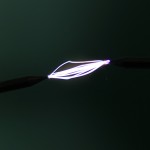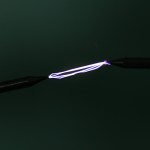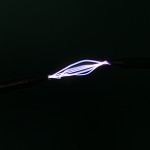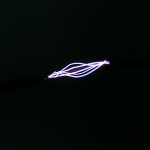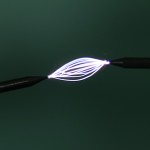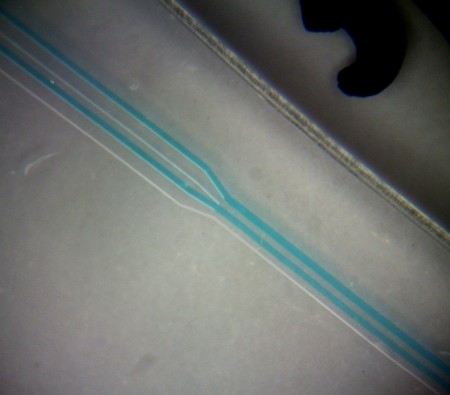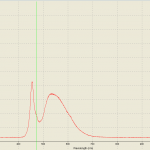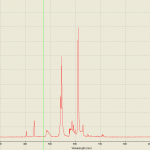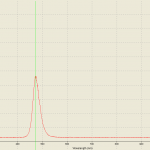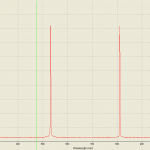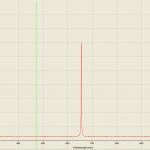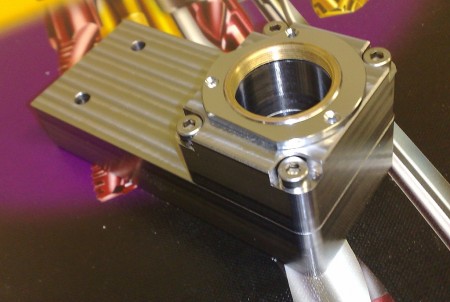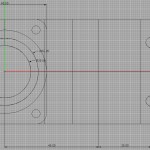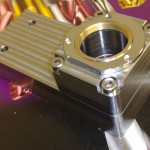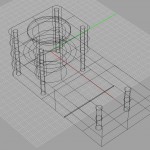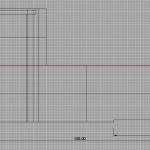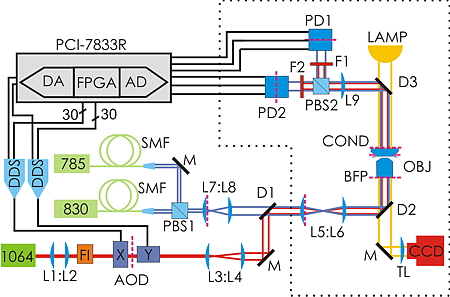A ~48 000 base-pair long (ca 16 um) piece of DNA is stretched between two optically trapped ca 2 um diameter polystyrene beads. Bright-field real-time view through a 100x microscope. Scale-bar in microns on the right.
Category: Research
Sparks
playing with entangled beads in optical tweezers
Were stretching a 13 kb DNA-construct between two optically trapped beads. This isn't a video of the experiment itself, but of some entangled beads we found in an old sample. The beads are 3 or 2 micron in diameter, and we hold on to the middle big bead with the optical trap while moving around the microscope stage. Hydrodynamic drag stretches out the chain of entangled beads. Not much, if any, scientific value, but a fun video nevertheless.
Laminar Flow
Life is simple at Reynolds numbers much below 0.1
Four 200 x 50 um inlet channels join into one 800 x 50 um main channel. The blue and clear liquids mix only by diffusion. See also here.
Spectrometer test
We got a new Ocean Optics spectrometer to the lab today and naturally I had to play around with it a bit in the evening. Compared to our 20+ year old Jobin Yvon rotating-grating thing this one is a very small tidy box, with data transmission and power over USB, and an SMA-connector for light input through a 600um core fiber.
Some sample spectra below (the filenames describe the light-source).
Nikon TE-2000 objective holder in steel
I'm fitting some more equipment around a Nikon TE-2000 microscope, and the stock objective turret is in the way. Machined this objective holder in steel yesterday.
Why can't AIP/Scitation do RSS feeds right?
I follow a number of scientific journals through their RSS feed of new articles. Google-reader makes it easy to stay on top of the 20 or so most interesting journals that each publish maybe 10 papers per week.
But now AIP and their website provider Scitation are messing it all up. They've decided to expand their archives and are putting scanned pdf articles from around 1979-1981 online. The trouble is these papers are showing up as new articles in the RSS feed! Not only that, but the text in the RSS feed shows the papers as appearing now, in 2008. It's only when you click through to the journal homepage that you realize the thing is 20+ years old.
This becomes very frustrating when suddenly APL or Rev.Sci.Instr indicates that they have 200 or more new papers! If they wanted to advertise to the world their 1980s physics they should do it with a different RSS feed.
I've emailed AIP and Scitation about this, but didn't get a reply. If you have the same problem I urge you to also email them and complain!
stroboscopic Schlieren videos
In an attempt to image the acoustic fields emerging from ultrasound transducers we've built a small Schlieren setup with stroboscopic LED illumination. There's a 10-cycle 7.5 MHz sound-wave coming in from the top at a velocity of around 1500 m/s, and if you illuminate it at just the right time with a 500 ns pulse of light you see the change in refractive index due to the pressure change. In the videos we are adjusting the delay between the acoustic pulse and the light-pulse from about 0 us up to 10 us to see how the sound propagates through the ~15 mm field of view.
Here's another one with a reflecting metal piece at the bottom. The reflected pulse shows quite nicely! If you look carefully between 3 and 4 s you can see an interference pattern between the incoming and reflected pulse.
An optical position clamp
Optical tweezers use light to trap dielectric particles in an approximately harmonic potential. If the position of the bead is X, the position of the trap Xtrap, and the stiffness of the trap k then the equation of motion looks like this:
where Beta is the drag coefficient and Ft is a random white-noise thermal force (the bead is so small that kicks and bumps by surrounding water-molecules matter!). If the trap stays in one place all the time (Xtrap is constant) the power-spectral-density (PSD) of the bead fluctuations turns out to be Lorentzian.
But if there's a fast way of steering the trap, we might try feedback control where we actively steer Xtrap based on some feedback signal:
This is a position-clamp where we use proportional feedback with gain Kp to keep the bead bead at some fixed set-point Xset. Tau accounts for some delay in measuring the bead position and in steering the trap. Inspired by a magnetic-tweezers paper by Gosse et al. we inserted this into the equation of motion to find the PSD:
So how do we go about verifying this experimentally? Well, you build something like this:
The idea is to use a powerful laser at 1064 nm for trapping. It can be steered with about a 10 us delay using AODs. Then we use another laser at 830 nm to detect the position of the trapped particle using back-focal-plane interferometry. But since in-loop measurements in feedback loops can give funny results it's best to verify the position measurement with a third laser at 785 nm. The feedback control is performed by a PCI-7833R DAQ card from National Instruments which houses an AD converter for reading in the position signals at 200 kS/s and 16-bit precision, and then we do the feedback algorithm on a 3 Mgate FPGA. We output the steering command as 30 bit numbers in parallel to DDSs that drive the AODs. The 10 us delay in the AOD (the acoustic time-of-flight in the crystal) combined with the AD-conversion time of 5 us gives a total loop-delay of around 15 us in our setup.
It all works quite nicely! The colored PSD traces are experimental data at increasing feedback gain starting from the blue trace at the top (zero gain, Lorentzian shape as expected) down to the black trace at the bottom (gain 24.8). When increasing the gain further trapping becomes unstable due to the peak at ~12 kHz (think about what's usually termed 'feedback': pointing a microphone at a loudspeaker). The theoretical PSDs are shown as solid lines and they agree pretty well with the experiment. The inset shows the effective trap stiffness calculated from the integral of the PSD. We're able to increase the lateral effective trap stiffness around 10-13 fold compared to the no-feedback situation.
This video shows a time-series of the bead position (left) and the trap position (right) first with no feedback where we see the bead fluctuating a lot and the trap stationary, and then with feedback gain applied (gain=7) where we see the bead-noise significantly reduced and the trap moving around.
These results appear as a 3-page write-up in today's Applied Physics Letters:
A.E. Wallin, H. Ojala, E. Haeggström, and R. Tuma, "Stiffer optical tweezers through real-time feedback control", Applied Physics Letters 92 (22) 224104 (2008) (doi:10.1063/1.2940339)
We're not the first ones to perform this experiment, but I would argue that our paper is the first one to do all steps in the experiment properly, and we get the nice agreement between theory and experiment.
An early paper by Simmons et al. claims a 400-fold improvement in effective trap stiffness using an analog feedback circuit. There's no discussion about the feedback bandwidth or the PSD when position-clamping. Perhaps a case of undersampling?
Simulations by Ranaweera et al. indicate that a 65-fold increase in effective trap stiffness can be achieved, but there's no discussion about how the delays in the feedback loop affect this, and there's no experimental verification.
More recently, Wulff et al. used steering mirrors to do the same thing, but they used the position detection signal from the trapping laser itself for feedback control. I'm not sure what this achieves since the coordinate-system in which you do position measurements is going to be steered around as you try to minimize fluctuations. Their PSDs don't look like ours, and the steering mirror has a bandwidth of only a few hundred Hz so you cannot control the high frequency noise like this.
Increasing the stiffness of optical tweezers by other means seems like a fashionable topic. A recent paper from Alfons van Blaaderen's group uses counter propagating beams to trap high-index (n>2) particles effectively, while simulations by Halina Rubinsztein-Dunlop's group indicate that anti-reflection coating the beads also improves trapping efficiency.
Pressure controller test
A test of the 8-channel 0-7 kPa microfluidic pressure controller today. We're looking through a 100x inverted microscope. There's a 2 um latex bead in a ~40 um wide channel formed between a glass coverslip and a PDMS layer. I'm hitting the keyboard to either increase or decrease the pressure in steps of +/-35 Pa which allows me to just barely keep the bead within the field of view during the 1 min video. The controller has plenty more resolution, down to about 1-2 Pa, so it should be possible to control flows down to <1 um/s. Stay tuned for more of the same later...
